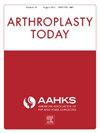Cefazolin Alone Versus Cefazolin With Tobramycin or Gentamicin as Intraoperative Antibiotic Prophylaxis for Total Joint Arthroplasty
IF 1.5
Q3 ORTHOPEDICS
引用次数: 0
Abstract
Background
Prosthetic joint infection is a serious complication of total knee arthroplasty (TKA) and total hip arthroplasty (THA). While cefazolin is the standard prophylactic antibiotic, some groups have considered adding aminoglycosides (gentamycin or tobramycin) to this regimen.
Methods
Adult primary THA and TKA patients were identified from 2010-2021 Q1 PearlDiver M151 database. Inclusion criteria were activity in the database ≥ 90 days postoperative and no infectious, neoplastic, or traumatic diagnoses within 90 days preoperative. Intraoperative antibiotic prophylaxis regimens were determined using Current Procedural Terminology J codes. For both THA and TKA, 2 subcohorts were created: (1) Patients who received cefazolin alone and (2) cefazolin and tobramycin or gentamicin. Differences in 90-day postoperative adverse outcomes were assessed with multivariable logistic regression controlling for age, sex, and Elixhauser Comorbidity Index. Five-year implant survival was assessed using Kaplan-Meier analysis and log-rank tests.
Results
For THA, 32,882 patients were identified, prophylactic cefazolin alone was given to 30,527 (92.8%), and cefazolin + gentamicin/tobramycin was given to 2355 (7.2%). For TKA, 119,611 patients were identified, prophylactic cefazolin alone was given to 110,469 (92.4%), and cefazolin + gentamicin/tobramycin was given to 9142 (7.6%). Overall SSI rate for THA was 1.1% and for TKA 0.8%. For both THA and TKA, antibiotic subgroups were clinically similar with regard to age, sex, and Elixhauser Comorbidity Index. On univariable and multivariable analysis, no 90-day outcomes varied significantly. Five-year implant survivals were not significantly different.
Conclusions
For THA and TKA, cefazolin alone vs cefazolin + gentamicin/tobramycin were not found to have differences in rates of perioperative adverse outcomes (including SSI/prosthetic joint infection) or 5-year revision rates.
求助全文
约1分钟内获得全文
求助全文
来源期刊

Arthroplasty Today
Medicine-Surgery
CiteScore
2.90
自引率
0.00%
发文量
258
审稿时长
40 weeks
期刊介绍:
Arthroplasty Today is a companion journal to the Journal of Arthroplasty. The journal Arthroplasty Today brings together the clinical and scientific foundations for joint replacement of the hip and knee in an open-access, online format. Arthroplasty Today solicits manuscripts of the highest quality from all areas of scientific endeavor that relate to joint replacement or the treatment of its complications, including those dealing with patient outcomes, economic and policy issues, prosthetic design, biomechanics, biomaterials, and biologic response to arthroplasty. The journal focuses on case reports. It is the purpose of Arthroplasty Today to present material to practicing orthopaedic surgeons that will keep them abreast of developments in the field, prove useful in the care of patients, and aid in understanding the scientific foundation of this subspecialty area of joint replacement. The international members of the Editorial Board provide a worldwide perspective for the journal''s area of interest. Their participation ensures that each issue of Arthroplasty Today provides the reader with timely, peer-reviewed articles of the highest quality.
 求助内容:
求助内容: 应助结果提醒方式:
应助结果提醒方式:


